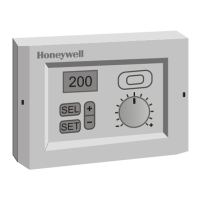
Do you have a question about the Honeywell MICRONIK 200 R7426A and is the answer not in the manual?
| Brand | Honeywell |
|---|---|
| Model | MICRONIK 200 R7426A |
| Category | Temperature Controller |
| Language | English |
Important checks and conditions before installing the controller.
Instructions for physically installing the controller in an enclosure or cabinet.
Details on connecting the power supply and grounding requirements for safe operation.
Configures output direction, operating range, and control range.
Configures setpoint adjustment, start-up routine, and output functions.
Selects the output mode for sequence or multistage ON/OFF functions.
Configures T2 signal use and selects high/low limit control type.
Selects sensor type and output control function Y1CTRF.
Configures time change, prestart gradients, and default programming.
Sets main setpoint (W1) and high/low limit setpoint (Wlim).
Configures submaster setpoint (Wcas) and reset span (Rcas).
Adjusts proportional band (Xp) and reset time (tr) for control loops.
Configures time change and prestart gradients for optimum start.
Adjusts self-adaptation speed and damper prestart time.
Sets communication address and initiates default parameter reset.
Configures compensation changeover, authority, and unoccupied setpoint offset.
Sets night mode offset and night cycle limits for space protection.
Describes display elements and how to change controller operating modes.
Calibrates temperature sensor inputs T1, T2, and T3.
Activates economizer mode and sets minimum damper position.
Configures actuator synchronization run time for outputs.
Explains how to navigate between different controller operating modes.
Describes how to select and display actual values on the controller.
Explains how to select and adjust configuration or parameter values.
Details resetting parameters to defaults and manually overriding output values.
Details programming the weekly schedule for controller modes.
Details programming holiday types (H1, H2, H3) for specific days.
Selects between clock, standard schedule, or holiday schedule for programming.
Adjusts the real-time clock (date and time).
Programs schedule points for weekdays and holiday types.
Identifies and displays errors for defective analog inputs (T1, T2, T3, XwRh).
